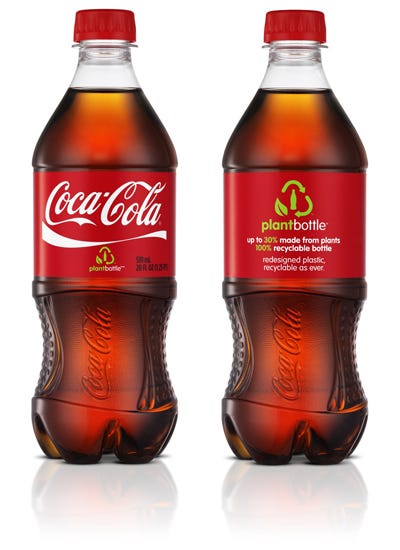When, in December 2009, Coca-Cola’s PlantBottle made its debut at the U.N. Copenhagen Climate Conference in Denmark, not everybody was convinced that the company was getting serious about sustainability.
November 15, 2012
When, in December 2009, Coca-Cola’s PlantBottle made its debut at the U.N. Copenhagen Climate Conference in Denmark, not everybody was convinced that the company was getting serious about sustainability.
Skeptics pointed out that simply calling the new packaging a PlantBottle did not change the fact that it was just another plastic bottle. Yet Coca-Cola has remained steadfast in its determination to pursue a greener course, reduce its dependency on oil—and at the same time, to sell more drinks. The ultimate goal by 2020: over three billion servings of its products a day, and PlantBottle technology for its entire virgin PET supply.
|
“When you look at what the goals mean in terms of impact—it’s huge,” said Klaus Stadler, Coca-Cola director Environment and Water Resources Europe, speaking at the European Bioplastics Conference in Berlin last week. “We’re already at 1.9 billion servings, up from 1.5 in 2010. We aim to more than double that, without doubling our impact on the environment. In fact, we want to keep that flat.”
He continued: “Today, 60% of our volume is sold in PET bottles. Which is why we’re looking so closely at that aspect. But: it’s not just about renewable material. It’s important to put in a recycling component, as well. That’s a responsible approach. So ultimately, no more oil-based materials will be needed: we’ll be using renewably-sourced and recycled material instead.”
Coca-Cola currently uses PET that is 30% renewably sourced in many of its core brands. Of the two main ingredients of PET—mono-ethylene glycol (MEG) and purified terephthalic acid (PTA)—the MEG portion, which makes up around 30% of the PET molecule by weight, can be produced from natural plant sources. The company is collaborating with different partners to develop bio PTA. One partner, Virent, has developed a route to make bio-based paraxylene (PX) via a process it calls BioForming. “We’re at the R&D level,” said Stadler.
Virent aims to commercialize its patented BioForming process before 2015, bringing the goal of a 100% PlantBottle tantalizingly close. The majority of the PX produced from Virent’s first plant will be allocated for purchase by The Coca-Cola Company’s supply chain partners for Coca-Cola’s product packaging.
“Of course, there’s a premium involved initially in the use of plant-based plastics,” said Stadler. “But as the scale increases, this will change. And we’ve just announced that JBF Industries will build a new MEG facility in Brazil, which will utilize locally sourced sugarcane and sugarcane processing waste in the manufacturing process. This will mean a big jump in supply—production capacity will be 500,000 metric tons of material per year—when the plant comes on stream in 2015. So we are getting scale, and that means price competitiveness on MEG.”
For Coca-Cola, bio PET is the most obvious alternative to conventional PET. “It’s a drop-in solution. It’s exactly the same as conventional PET, and can be used in the same production facilities,” says Stadler. Asked whether the collaboration with renewable chemicals company Avantium, to further co-develop Avantium's YXY technology for producing PET bottles was a route the company was seriously pursuing, he replied that Coca-Cola thought it was an interesting proposition.
The PlantBottle project is one that is demanding collaboration on all fronts. Not only is it paramount to ensure that all first generation biomass feedstocks, sugarcane, are sustainably sourced through the Bonsucro standard, research is ongoing to develop second-generation biomass feedstock, “typically cellulosics,” said Stadler, “and this is now starting to gain traction. It will happen in another one to three years. However, the biomass has to be affordable, as cost is a key driver.” Coca-Cola is setting up partnerships to establish a sustainable, eco-viable supply chain for feedstock, relevant to geographical location.
Today, three years after its introduction, Coca-Cola has commercialized the PlantBottle in some 20 different countries, 10 of which are in Europe. “We’ve put 13 billion PlantBottles into the marketplace in the past three years, and will continue to work towards our goal of 100% of virgin PET resin to contain PlantBottle Packaging Technology 1.0 by 2020. We are totally committed to the move away from fossil material to renewable in bottles.”
About the Author(s)
You May Also Like




